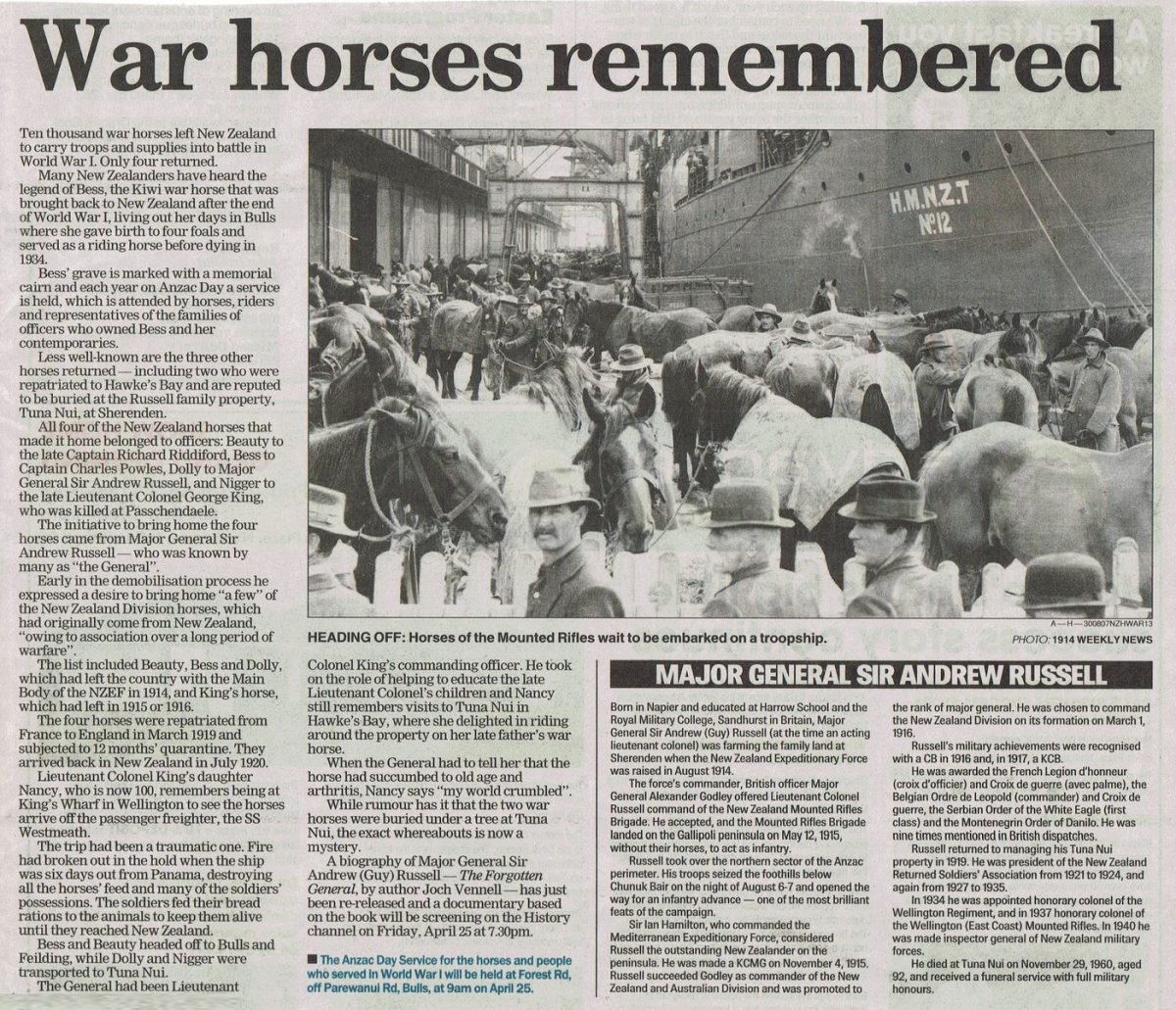War horses remembered
Ten thousand war horses left New Zealand to carry troops and supplies into battle in World War I. Only four returned.
Many New Zealanders have heard the legend of Bess, the Kiwi war horse that was brought back to New Zealand after the end of World War I, living out her days in Bulls where she gave birth to four foals and served as a riding horse before dying in 1934.
Bess’ grave is marked with a memorial cairn and each year on Anzac Day a service is held, which is attended by horses, riders and representatives of the families of officers who owned Bess and her contemporaries.
Less well-known are the three other horses returned – including two who were repatriated to Hawke’s Bay and are reputed to be buried at the Russell family property, Tuna Nui, at Sherenden.
All four of the New Zealand horses that made it home belonged to officers: Beauty to the late Captain Richard Riddiford, Bess to Captain Charles Powles, Dolly to Major General Sir Andrew Russell, and Nigger to the late Lieutenant Colonel George King, who was killed at Passchendaele.
The initiative to bring home the four horses came from Major General Sir Andrew Russell – who was known by many as “the General”.
Early in the demobilisation process he expressed a desire to bring home “a few” of the New Zealand Division horses, which had originally come from New Zealand, “owing to association over a long period of warfare”.
The list included Beauty, Bess and Dolly, which had left the country with the Main Body of the NZEF in 1914, and King’s horse, which had left in 1915 or 1916.
The four horses were repatriated from France to England in March 1919 and subjected to 12 months’ quarantine. They arrived back in New Zealand in July 1920.
Lieutenant Colonel King’s daughter Nancy, who is now 100, remembers being at King’s Wharf in Wellington to see the horses arrive off the passenger freighter, the SS Westmeath.
The trip had been a traumatic one. Fire had broken out in the hold when the ship was six days out from Panama, destroying all the horses’ feed and many of the soldiers’ possessions. The soldiers fed their bread rations to the animals to keep them alive until they reached New Zealand.
Bess and Beauty headed off to Bulls and Feilding, while Dolly and Nigger were transported to Tuna Nui.
The General had been Lieutenant Colonel King’s commanding officer. He took on the role of helping to educate the late Lieutenant Colonel’s children and Nancy still remembers visits to Tuna Nui in Hawke’s Bay, where she delighted in riding around the property on her late father’s war horse.
When the General had to tell her that the horse had succumbed to old age and arthritis, Nancy says “my world crumbled”.
While rumour has it that the two war horses were buried under a tree at Tuna Nui, the exact whereabouts is now a mystery.
A biography of Major General Sir Andrew (Guy) Russell – The Forgotten General, by author Joch [Jock] Vennell – has just been re-released and a documentary based on the book will be screening on the History channel on Friday, April 25 at 7.30pm.
The Anzac Day Service for the horses and people who served in World War I will be held at Forest Rd, off Parewanul Rd, Bulls, at 9am on April 25.
Photo caption – HEADING OFF: Horses of the Mounted Rifles wait to be embarked on a troopship.
PHOTO: 1914 WEEKLY NEWS
MAJOR GENERAL SIR ANDREW RUSSELL
Born in Napier and educated at Harrow School and the Royal Military College, Sandhurst in Britain, Major General Sir Andrew (Guy) Russell (at the time an acting lieutenant colonel) was farming the family land at Sherenden when the New Zealand Expeditionary Force was raised in August 1914.
The force’s commander, British officer Major General Alexander Godley offered Lieutenant Colonel Russell command of the New Zealand Mounted Rifles Brigade. He accepted, and the Mounted Rifles Brigade landed on the Gallipoli peninsula on May 12, 1915, without their horses, to act as infantry.
Russell took over the northern sector of the Anzac perimeter. His troops seized the foothills below Chunuk Bair on the night of August 6-7 and opened the way for an infantry advance-one of the most brilliant feats of the campaign.
Sir Ian Hamilton, who commanded the Mediterranean Expeditionary Force, considered Russell the outstanding New Zealander on the peninsula. He was made a KCMG on November 4, 1915. Russell succeeded Godley as commander of the New Zealand and Australian Division and was promoted to the rank of major general. He was chosen to command the New Zealand Division on its formation on March 1, 1916.
Russell’s military achievements were recognised with a CB in 1916 and, in 1917, a KCB.
He was awarded the French Legion d’honneur (croix d’officier) and Croix de guerre (avec palme), the Belgian Ordre de Leopold (commander) and Croix de guerre, the Serbian Order of the White Eagle (first class) and the Montenegrin Order of Danilo. He was nine times mentioned in British dispatches.
Russell returned to managing his Tuna Nui property in 1919. He was president of the New Zealand Returned Soldiers’ Association from 1921 to 1924, and again from 1927 to 1935.
In 1934 he was appointed honorary colonel of the Wellington Regiment, and in 1937 honorary colonel of the Wellington (East Coast) Mounted Rifles. In 1940 he was made inspector general of New Zealand military forces.
He died at Tuna Nui on November 29,1960, aged 92, and received a funeral service with full military honours.












Do you know something about this record?
Please note we cannot verify the accuracy of any information posted by the community.